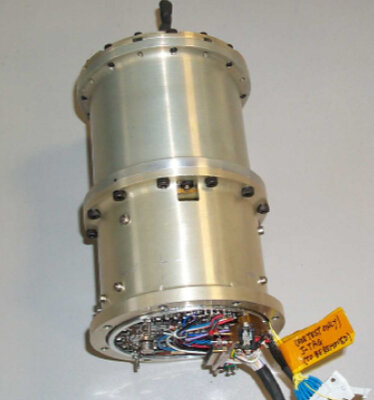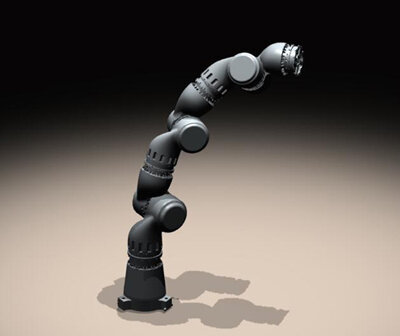Dextrous robot arm
The ESA Dextrous robot Arm (DexArm) project is engaged in the design and development of a robot arm comparable in size, force capabilities and dexterity to a human arm, suitable for space applications.
The first programme to make use of DexArm is Eurobot, a three arm robot complementary in capability to a human being engaged in Extra-Vehicular Activity (EVA). Eurobot will be used for extra-vehicular operations on the International Space Station, for example: moving along the space station structure using standard EVA interfaces, execution of, or provision of support to, routine EVA tasks, and replacement of Orbital Replacement Units (ORUs).
One set of design constraints for DexArm results from it having to withstand the harsh environment of space. Beyond these requirements however, the main challenges for the development team came with the minimisation of resource usage.
To achieve this goal, ESA has encouraged the use of innovative approaches and technologies to drastically reduce mass, volume and power consumption while providing adequate performance in terms of both torque/force capability and positioning accuracy and repeatability.
Development phases
The DexArm project is being implemented in three phases. The first two phases focused on system requirements, arm architecture and the design and development of a prototype joint for the arm.
Two designs of joint have been produced. The two prototypes made use of different components and had different architectural implementations. During testing, they both exhibited remarkable performance. However, only one prototype was selected for continued development.
The third phase, currently ongoing, is the development of an engineering model of DexArm. The prototype joint selected for continued development has been re-designed in order to integrate changes deemed necessary to improve the already good performance and further reduce resource usage.
The re-engineered prototype has then been used as a basic component for the design of the robot arm.
DexArm joints

The prototype joint is a truly complex mechatronic device. It integrates all the mechanical, electronics and computing elements needed to achieve high precision/high torque rotary motion. The joint is composed of:
- a high performance brushless DC motor, which uses an innovative stratified winding system and non laminated soft magnetic material,
- an electromagnetic fail-safe brake, customized to consume low power
- an ultra-thin Harmonic Drive™ gear,
- an Electric-Encoder™ as the angular sensor for the input shaft,
- a resolver as the angular sensor for the output shaft,
- a custom-made torque sensor (based on strain-gauges) designed to provide high stiffness and high torque sensitivity at the same time.
- a DSP based digital motion controller which implements position, speed and torque control of the joint and interfaces to the outside through a digital serial bus
- a high efficiency power stage based on low-resistance MOSFETs.
- a high-efficiency power supply
Thanks to the bus-type connectivity, up to 255 joints can be connected with a single cable bundle.
| DexArm joint characteristics | |
|---|---|
| Parameter | Value |
| Mass | 2.9 kg |
| Size (overall) | diameter = 112 mm length = 175.2 mm |
| Central hole for cable passage | diameter = 16.5 mm |
| Maximum output torque | 100 Nm |
| Worst case power consumption | 20 W |
| Nominal power consumption | 7.7 W |
| Minimum output shaft speed | 6.3 * 10-6 rad/s |
| Maximum output shaft speed (at no load) |
0.5 rad/s |
| Positioning accuracy | 0.01 deg (1.74 * 10-4 rad) |
| Positioning repeatability | 0.00016 deg (2.8 * 10-6 rad) |
| Operating temperature | -30 °C to +70 °C |
| Non-operating temperature | -55 °C to + 125 °C |
DexArm configuration

A comparative analysis of the performance in dexterity, cable passing, folding capabilities and human arm similarity was carried out on selected basic robot architectures featuring different geometric arrangements of seven joints.
The architecture that showed best results made use of roll joints alternating with pitch joints having an asymmetrical movement range.
Based on this architecture, which only tells how joints are disposed in space, robot limbs were designed. Robot limbs must accommodate sets of very contradicting requirements. On one hand they must be very stiff (to allow high robot precision) on the other hand they must be very lightweight. Also they need to maintain a given joint position very firmly, yet allow the joints to move freely throughout their design range.
Current results

DexArm development is ongoing. Although the final result is not yet available, there is high confidence that DexArm will meet the requirements of the EuroBot application. Furthermore, its architecture and basic components are sufficiently flexible and powerful to be re-used for other space applications.
More information
The following papers can be downloaded via the ASTRA proceedings link at the right of this page:
- DEXARM a dextrous robot arm for space applications, Rusconi A, Magnani P G,Grasso T.Proceedings of the 8th ESA Workshop on Advanced Space Technologies for Robotics and Automation, November, 2004
- “ Design and Development of an Integrated Joint for the Dextrous Robot Arm” ,Rusconi, A.; Magnani, P.; Gonzalez Lodoso, J.F.; Campo, P.; Chomicz, R.; Magnani, G., Proceedings of the 9th ESA Workshop on Advanced Space Technologies for Robotics and Automation 28-29-30 November 2006
- Dextrous Robot Arm - Design, Implementation and Test of a Robotic Joint, Schuler, S.; Houghton, P.; Gruener, G.; Heemskerk, C.J.M.; Pereira, C. Proceedings of the 9th ESA Workshop on Advanced Space Technologies for Robotics and Automation 28-29-30 November 2006




